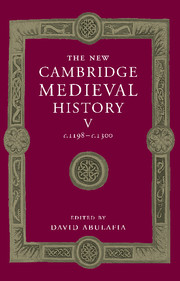Book contents
- Frontmatter
- Introduction
- Part I Common Themes
- Part II The Church in the Thirteenth Century
- Part III The Western Kingdoms
- Part IV Italy
- Part V The Mediterranean Frontiers
- 17 Byzantium after the Fourth Crusade
- (a) The Latin empire of Constantinople and the Frankish states in Greece
- (b) Byzantium in exile
- 18 The crusades
- 19 Islam and the Mediterranean
- 20 The rise of Aragon-Catalonia
- 21 Castile, Portugal and Navarre
- Part VI The Northern and Eastern Frontiers
- Appendix Genealogical tables
- Primary sources and secondary works arranged by chapter
- Index
- Plate section
- Map 1 Europe in the thirteenth century
- Map 3 France, c. 1260
- Map 5 Germany and the western empire
- Map 6 Genoa, Venice and the Mediterranean
- Map 8 The Latin empire of Constantinople and its neighbours
- Map 10 Aragon and Anjouin the Mediterranean">
- References
(a) - The Latin empire of Constantinople and the Frankish states in Greece
from 17 - Byzantium after the Fourth Crusade
Published online by Cambridge University Press: 28 March 2008
- Frontmatter
- Introduction
- Part I Common Themes
- Part II The Church in the Thirteenth Century
- Part III The Western Kingdoms
- Part IV Italy
- Part V The Mediterranean Frontiers
- 17 Byzantium after the Fourth Crusade
- (a) The Latin empire of Constantinople and the Frankish states in Greece
- (b) Byzantium in exile
- 18 The crusades
- 19 Islam and the Mediterranean
- 20 The rise of Aragon-Catalonia
- 21 Castile, Portugal and Navarre
- Part VI The Northern and Eastern Frontiers
- Appendix Genealogical tables
- Primary sources and secondary works arranged by chapter
- Index
- Plate section
- Map 1 Europe in the thirteenth century
- Map 3 France, c. 1260
- Map 5 Germany and the western empire
- Map 6 Genoa, Venice and the Mediterranean
- Map 8 The Latin empire of Constantinople and its neighbours
- Map 10 Aragon and Anjouin the Mediterranean">
- References
Summary
THE western or Latin conquest of Constantinople on 13 April 1204 heralded a new era in the history of the Byzantine lands, known in the west as Romania. It was a severe blow to the military might, political organisation and prestige of the empire. Moreover, it furthered and hastened its disintegration, initiated some twenty-five years earlier, and led to its dismemberment. In March 1204, about a month before the fall of Constantinople, the leaders of the ‘French’ crusader armies and the commander of the Venetian army and fleet, Doge Enrico Dandolo, reached an agreement in which they addressed five major issues: the election of the Latin emperor, the political regime of the empire, its military organisation, the partition of the lands of Romania and, finally, the election of the Latin patriarch of Constantinople and other ecclesiastical matters. On 9 May 1204 Count Baldwin IX of Flanders, and VI of Hainault, was elected emperor with a share comprising two imperial palaces at Constantinople and a quarter of the empire. Emperor Baldwin I (1204–5) awarded out of his domain many fiefs to knights and mounted sergeants of the ‘French’ host and assigned to Venice its portion, three-eighths of it in land and revenues. The remaining three-quarters of Romania were equally divided between the ‘French’ or Frankish crusaders and Venice. By then only Constantinople was in Latin hands. The difficulties encountered in the conquest of Romania, which was never completed, and the individual expeditions undertaken by Latin knights or commoners, as well as by the Venetian state, prevented the systematic implementation of the partition plan. Instead, the extensive territories occupied by the Latins became a mosaic of political entities, many of them small, whose rulers were linked to each other within a complex and shifting web of vassal relations.
Keywords
- Type
- Chapter
- Information
- The New Cambridge Medieval History , pp. 523 - 542Publisher: Cambridge University PressPrint publication year: 1999
References
- 1
- Cited by



